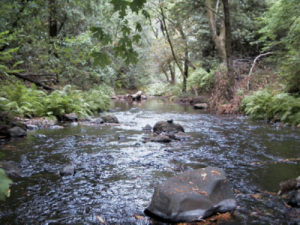Healthy watersheds

A watershed is all of the land that drains to a particular:
- Stream
- River, or
- Bay
From the wildest preserve to the most densely developed urban neighborhood, all land is part of a watershed.
When watersheds are healthy and functioning well, they provide food, fiber, clean water, and habitat for native plants and animals.
Healthy watersheds work hard. They:
- Move sediment from the mountains to beaches and bays, sorting it along the way to create diverse landscapes and habitats
- Cycle nutrients and convert them into forms that living organisms can use
- Purify and store water, slowly releasing it back into streams to reduce flooding and erosion in the winter and to sustain cool water flows during the dry season
- Improve air quality by absorbing pollutants and greenhouse gases
Healthy watersheds are more resilient to natural and human-induced disturbances than highly-impacted watersheds.
Desired characteristics
Here are some characteristics of a healthy watershed:
-
Good water quality supports native aquatic species, such as steelhead trout, coho salmon, and the aquatic insects they eat.
-
Streams and their floodplains accommodate flood flows without regular destructive flooding and erosion.
-
Stream flows resemble historic conditions, with stable summer baseflows and moderate peak flows after winter storms.
-
Hard, impervious surfaces such as roofs and pavements are well managed, especially where ditches and storm drains connect them to streams.
-
Streams have complex habitat features such as pools, gravel bars, and large wood that support fish and other aquatic species even through short-term changes from drought, wildlfire, landslides, or other events that alter habitat conditions in parts of the system.
-
Native, keystone plant and animal species are able to sustain stable populations. Examples in Marin County include Ridgway's rail, valley live oak, steelhead trout, and spotted owl.
-
Riparian corridors have a dense, healthy native plant community that regenerates naturally.
-
Upland forests and grasslands promote rain infiltration, provide diverse native wildlife habitat, reduce soil erosion, and filter runoff.
-
Tidal areas are connected to their wetlands.
What you can do
Here are things you can do to help your watershed's health:
- Identify what watershed you live and/or work in, and learn more about its specific issues and challenges.
- If you are a landowner, learn about good creek stewardship.
- Plant native plants that fit your specific location and conditions. When you can, plant a variety of species and types of plants from grasses for erosion control and wildflowers for bees and butterflies, to shrubs and trees for birds and healthy streams.
- Reduce impervious surfaces and disconnect them from streams and storm drains. Use porous alternatives such as gravel or pervious pavement for driveways and paths. Collect roof runoff and slow its release through rain barrels, rain gardens, and bioswales.
- Keep water clean. Prevent soil erosion, use non-toxic household and garden products, keep oil and animal waste out of streams and storm drains.
- Repair erosion wherever possible with biotechnical techniques that incorporate native plants. These methods allow for natural watershed functions to continue.
- Protect and restore riparian areas.
- Learn how healthy watersheds help fight climate change, and can help address sea level rise.
